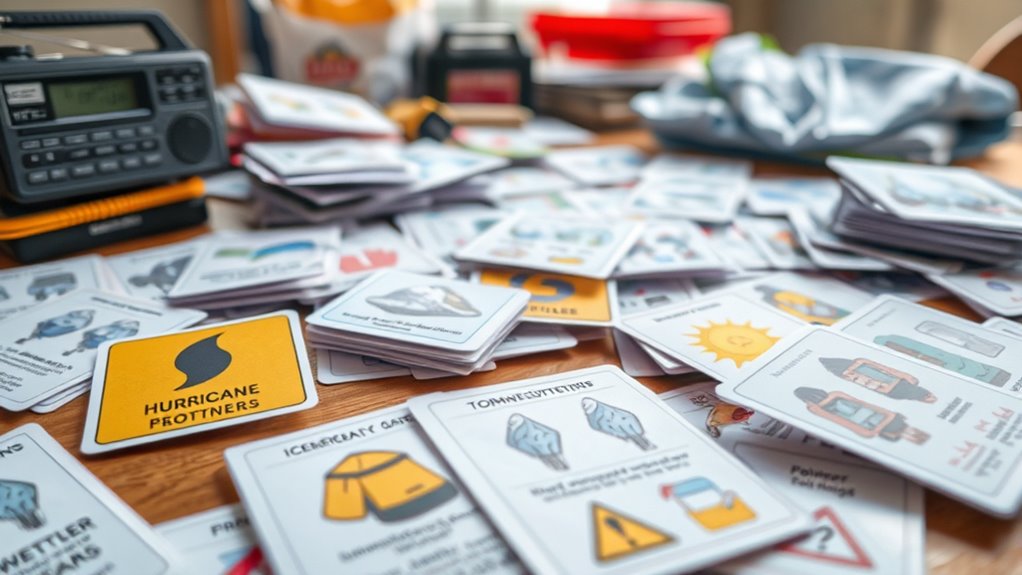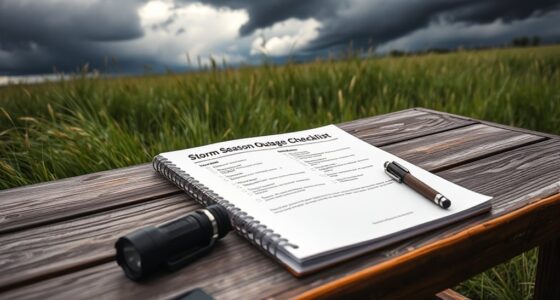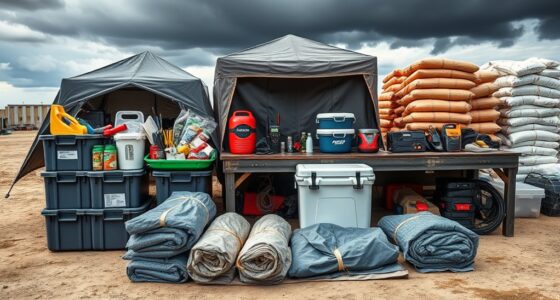To master the hurricane versus ice storm prep glossary in a weekend, start by understanding key weather terms like storm surge, wind shear, and ice accumulation. Learn how hurricanes generate high winds, storm surge, and flooding, while ice storms cause dangerous freezing rain and power outages. Familiarize yourself with essential supplies like water, non-perishable food, and emergency lighting. Recognize safety precautions and alert systems to stay prepared. Keep exploring to uncover detailed strategies that can boost your readiness for both storms.
Key Takeaways
- Focus on understanding key terms like storm surge, wind shear, ice accumulation, and hazard alerts for quick recall.
- Compare storm characteristics—hurricanes involve high winds and surge; ice storms feature freezing rain and ice buildup.
- Study scenario-based preparedness to identify vulnerabilities and appropriate responses for each storm type.
- Familiarize yourself with emergency supplies and safety measures specific to hurricanes and ice storms.
- Use trusted weather apps and alerts to stay informed and practice clear communication and evacuation plans.
Understanding Basic Weather Terminology

Understanding basic weather terminology is essential for preparing effectively for hurricanes and ice storms. Knowing what a storm surge is helps you recognize the potential for rapid flooding during hurricanes, especially along coastlines. Storm surge refers to the abnormal rise of seawater caused by a hurricane’s strong winds pushing water onto land. Wind shear, on the other hand, describes the change in wind speed or direction with altitude. High wind shear can weaken a hurricane or prevent it from strengthening, while low wind shear allows storms to grow more intense. By understanding these terms, you can better interpret weather forecasts and warnings, making smarter decisions about evacuation and safety measures. Clear terminology empowers you to stay informed and react swiftly in severe weather situations. Additionally, understanding the energetic alignment between different weather factors can enhance your ability to anticipate storm behavior and prepare accordingly.
Key Characteristics of Hurricanes and Ice Storms

Hurricanes and ice storms each have distinct features that influence how you should prepare for them. Hurricanes are characterized by high wind intensity, which can cause significant structural damage, and a storm surge that raises water levels along coastlines, flooding communities. These storms typically develop over warm ocean waters and can last for days, delivering fierce winds and heavy rain. In contrast, ice storms produce freezing rain that coats surfaces in thick ice, making roads treacherous and power lines vulnerable. Their key characteristic is the buildup of ice rather than wind or water surge. While hurricanes threaten with powerful winds and flooding, ice storms primarily cause damage through ice accumulation, leading to fallen trees and widespread outages. Recognizing these differences helps you plan effectively for each storm type.
Essential Emergency Supplies and Their Names
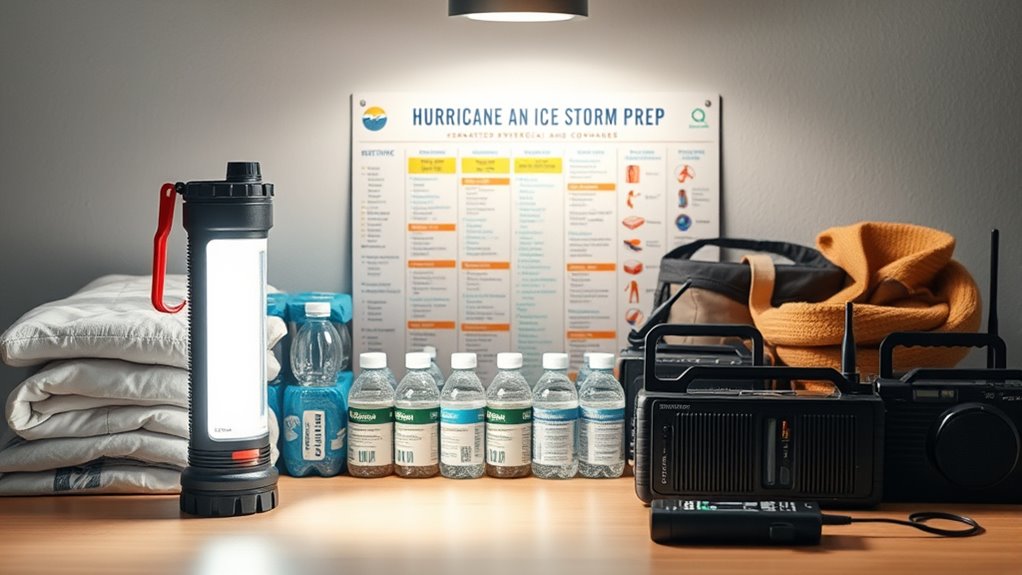
Having the right emergency supplies can make all the difference during a storm. You’ll need essentials like water and hydration gear, non-perishable food, and reliable lighting and power sources. Knowing their names and proper use helps you prepare effectively and stay safe. Additionally, understanding water filtration systems can ensure access to clean drinking water in emergency situations.
Water and Hydration Gear
Ensuring you have the right water and hydration gear is essential for staying safe during a hurricane or ice storm. Proper hydration techniques and water filtration tools help prevent dehydration and guarantee access to clean water. Carry durable water bottles or hydration packs for easy transport. Consider portable water filters or purification tablets to treat water from natural sources if supplies run low.
| Gear Item | Description |
|---|---|
| Reusable Water Bottles | Durable bottles for daily hydration |
| Water Filters | Devices for water purification |
| Hydration Packs | Backpack systems with built-in reservoirs |
| Water Purification Tablets | Chemical treatment for water safety |
Non-Perishable Food Items
Stocking up on non-perishable food items is essential for maintaining energy and health during a storm. Canned goods, such as soups, vegetables, and meats, provide quick, reliable nutrition without refrigeration. Dried snacks like trail mix, granola bars, and dried fruits are lightweight, portable, and have a long shelf life, making them perfect for emergency kits. Make sure you have a variety of options to keep your diet balanced and avoid boredom. Focus on foods that require minimal preparation and have a high calorie count to sustain your energy levels. Remember to check expiration dates regularly and rotate supplies to keep everything fresh. Having an ample supply of canned goods and dried snacks ensures you’re prepared to weather the storm with the necessary sustenance. Additionally, choosing lightweight and portable options can make it easier to manage your supplies during an emergency.
Lighting and Power Sources
After gathering non-perishable foods to keep you energized, it’s equally important to have reliable lighting and power sources ready. Solar backups are an excellent eco-friendly option, providing light and charging devices without fuel or electricity. Keep flashlights, batteries, and lanterns accessible, and verify they’re in good working order. If you rely on a generator, prioritize generator safety by placing it outdoors and away from vents to prevent carbon monoxide buildup. Always follow manufacturer instructions and never operate a generator indoors. Consider investing in portable power stations for added flexibility. Ensuring your backup power options are reliable and properly maintained can significantly improve your safety during outages. Having these supplies prepared ensures you stay illuminated and connected during power outages, reducing hazards and keeping your household safe until electricity returns.
Common Safety Measures and Precautions
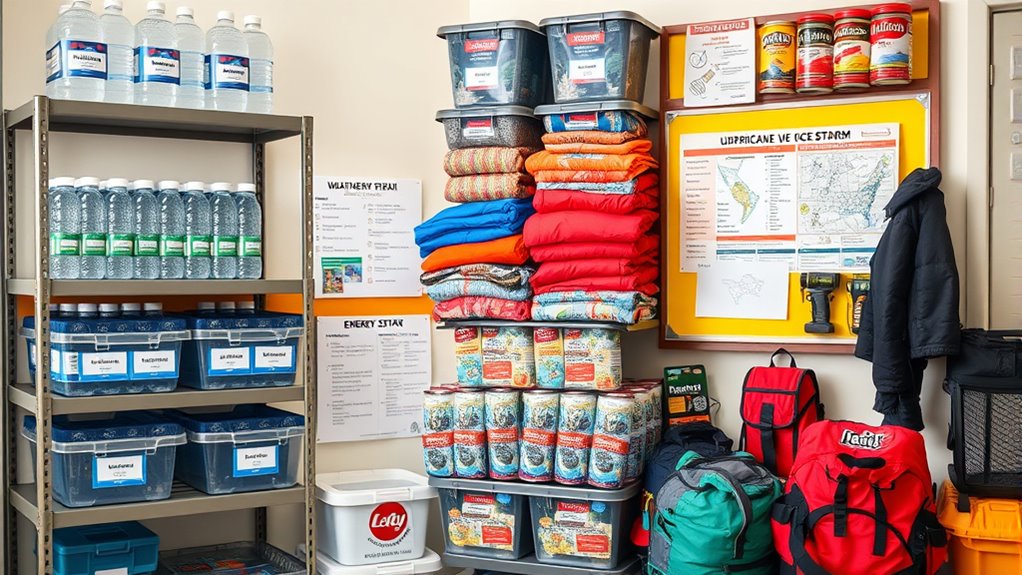
When preparing for hurricanes or ice storms, taking essential safety measures can make a significant difference in protecting yourself and your loved ones. Start by reviewing evacuation procedures so everyone knows the safest routes and shelter locations. Keep emergency kits stocked with water, non-perishable food, medications, and important documents. Follow home safety tips such as securing windows, trimming trees near your house, and unplugging electronics to prevent damage. Confirm flashlights, batteries, and first aid supplies are accessible. Stay informed through weather alerts and avoid unsafe areas during storms. Signs of spoilage in food items should also be checked to prevent illness. Communicate your plans with family members and neighbors to ensure everyone is prepared. Taking these precautions minimizes risks and helps you respond quickly and effectively when a storm strikes.
Navigating Communication and Alert Systems

Understanding the different alert types helps you respond quickly during storms, so you know what actions to take. Using emergency apps keeps you informed in real-time, ensuring you don’t miss critical updates. Mastering these tools makes your communication during emergencies more effective and reliable. Additionally, familiarizing yourself with sustainable communication methods can help you stay connected even during power outages or infrastructure disruptions.
Understanding Alert Types
Managing the different alert types is essential for staying informed and safe during severe weather events. Understanding alerts helps you interpret warnings like storm surge or high wind speed, so you can respond appropriately. For example, a hurricane warning indicates immediate danger, prompting evacuation or sheltering in place. A tornado watch signals you to stay alert, while a tornado warning requires urgent action. Alerts may come through various channels, such as sirens, text messages, or official broadcasts. Recognizing these alerts allows you to prioritize safety measures effectively. Stay aware of the specific terminology used for storm surge levels or wind speed thresholds, so you know exactly what the situation demands. Being familiar with water-related hazards like flooding or wave surge can further improve your preparedness. Mastering alert types ensures you’re prepared to act swiftly and protect yourself and your loved ones.
Utilizing Emergency Apps
Emergency apps are vital tools that keep you informed during severe weather events by delivering real-time alerts directly to your smartphone. Mobile alert systems and emergency notification apps ensure you receive timely updates about hurricanes or ice storms, helping you stay prepared. Download and familiarize yourself with trusted apps like the FEMA app, weather service apps, or local emergency management systems. Enable notifications and location services to get alerts specific to your area. These apps often provide critical instructions, safety tips, and evacuation information, making them essential for steering communication during emergencies. Regularly check for updates and test notifications to guarantee your devices are configured correctly. Using these emergency notification apps effectively can make a significant difference in your safety and response during severe weather events. Additionally, understanding how high contrast ratios affect your visual awareness during power outages or low-light conditions can help you interpret alerts more effectively.
Identifying Critical Infrastructure and Resources
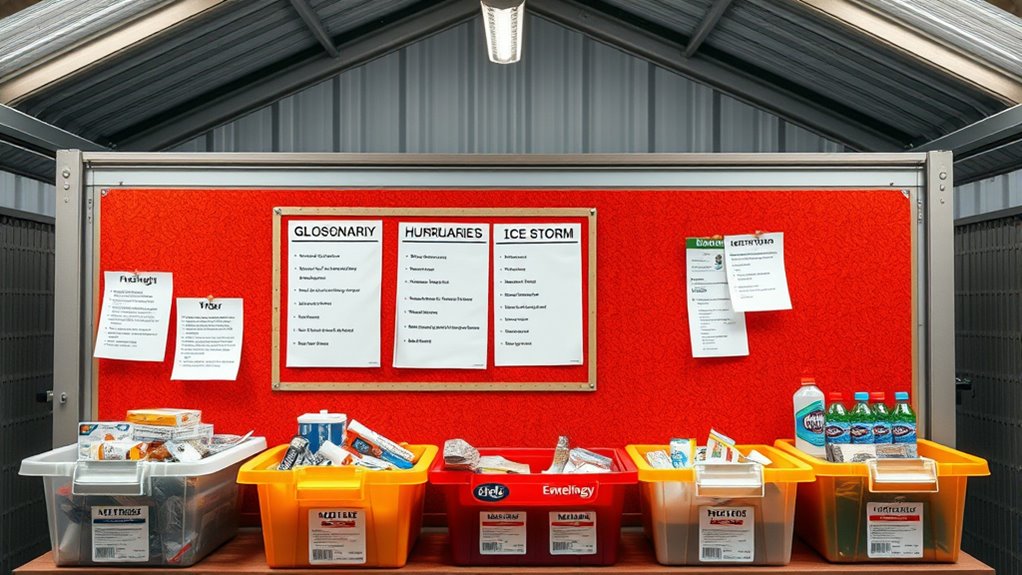
Have you identified the essential infrastructure and resources needed to stay safe and connected during a hurricane or ice storm? Critical infrastructure includes power supplies, communication networks, transportation routes, and emergency services—these are indispensable for your safety and recovery. Focus on resource prioritization by determining which items are most crucial, such as potable water, non-perishable food, batteries, and medical supplies. Recognizing these essentials helps you allocate your resources efficiently, ensuring you’re prepared for possible outages or disruptions. Make a list of local emergency facilities, utility contacts, and supply sources. Additionally, understanding the importance of essential oils for emergency relief can provide comfort and aid in managing stress during a crisis. By understanding what infrastructure is critical and prioritizing your resources, you can act swiftly and effectively, reducing risks and ensuring you’re ready to face the storm’s impact.
Recognizing Weather Warnings and Advisories

Understanding the weather warnings and advisories issued for hurricanes and ice storms is essential for effective preparedness. By staying alert to official alerts, you can act swiftly to protect yourself and your property. Use storm tracking tools to monitor the storm’s movement and intensity in real-time. Pay attention to specific warnings like hurricane watches, warnings, or ice storm advisories, which indicate the severity and expected impact. Analyzing weather patterns helps you anticipate changes and decide when to take action. Recognizing the differences between advisories ensures you respond appropriately, whether it’s evacuating, securing your home, or preparing emergency supplies. Staying informed through trusted sources and understanding these alerts helps you make timely decisions, reducing risks during severe winter weather events.
Practicing Your Knowledge With Real-Life Scenarios
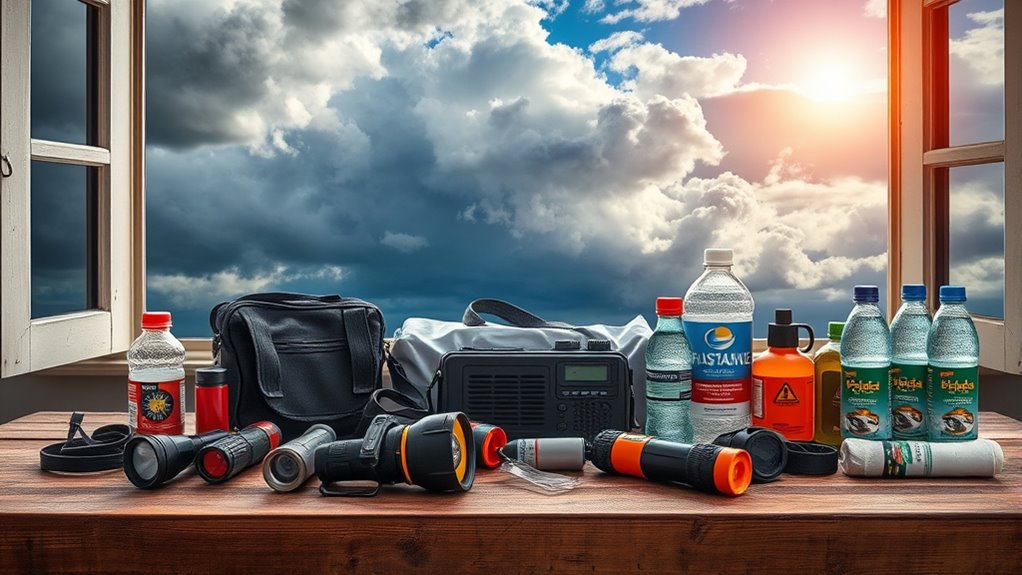
Practicing your knowledge through real-life scenarios helps you prepare effectively for hurricanes and ice storms. It allows you to identify potential challenges, like managing storm surge or preventing dangerous ice accumulation. Try simulating a storm evacuation or evaluating your home’s vulnerabilities. Use the table below to test your understanding of key terms and responses:
| Scenario | Key Concern | Action Needed |
|---|---|---|
| Hurricane approaching coast | Storm surge | Evacuate or reinforce property |
| Ice storm with heavy accumulation | Ice accumulation | Keep walks clear and stay indoors |
| Power outage during storm | Emergency supplies | Use backup generators safely |
| Flooding risk from storm surge | Property damage | Move valuables to higher ground |
| Cold temperatures and ice | Hypothermia risk | Dress warmly, limit outdoor activity |
Rehearse these scenarios to strengthen your readiness and response skills. Additionally, understanding the vulnerabilities of your home can help you better prepare for extreme weather events.
Frequently Asked Questions
How Can I Distinguish Between a Hurricane Watch and Warning?
You can distinguish between a hurricane watch and warning by paying close attention to weather alerts. A hurricane watch means tropical storm conditions are possible within 48 hours, so you should prepare. A warning indicates hurricane conditions are expected within 36 hours, signaling you must take immediate action. Stay vigilant with storm preparedness, monitor official updates, and act quickly when alerts escalate to guarantee your safety during severe weather.
What Are the Signs of a Developing Ice Storm?
Did you know that ice storms can cause up to 1 inch of ice accumulation in just a few hours? Signs of a developing ice storm include sudden temperature drops and increasing cloud cover. You’ll notice freezing rain begins to coat surfaces, trees, and power lines, leading to dangerous conditions. Stay alert if the forecast predicts falling temperatures and icy precipitation, so you can prepare before the ice accumulation becomes severe.
Which Emergency Supplies Are Most Critical for Hurricanes Versus Ice Storms?
For hurricanes, make certain your emergency kit includes water, non-perishable food, flashlights, batteries, and a portable phone charger. You should also know storm shelter locations nearby. For ice storms, prioritize warm clothing, blankets, a battery-powered heater, and supplies to keep your water from freezing. Both storms require sturdy emergency kit essentials, but for ice storms, focus more on heating and insulation, and always have a plan to reach storm shelter locations quickly.
How Do Communication Systems Differ During Hurricanes and Ice Storms?
During hurricanes, satellite communication and radio broadcasting remain essential for real-time updates and emergency alerts, especially when power outages disrupt regular services. In ice storms, these systems help coordinate rescue efforts and provide weather forecasts, but you might rely more on local radio broadcasts due to potential satellite dish damage from ice accumulation. Keep backup power sources ready to guarantee continuous communication during both events.
What Post-Storm Safety Procedures Should I Follow After Each Event?
After each storm, prioritize your safety by avoiding downed power lines and unstable structures during post-storm cleanup. Check your home for damage, and document it for insurance claims. Remember, storm recovery can be stressful, so seek mental health support if needed. Keep communication lines open with loved ones, and stay informed about local updates. Your safety and well-being are vital during this recovery phase.
Conclusion
By mastering the mastery of meteorological meanings, you’ll confidently confront hurricanes and ice storms. Remember, readiness reduces risk, and knowledge keeps you safe. Stay sharp, stay savvy, and stay secure by studying the specifics swiftly. With a little effort and a willingness to learn, you’ll be well-equipped to weather any storm that comes your way. So, start studying today, and turn chaos into confidence—because preparedness is your best protection.
